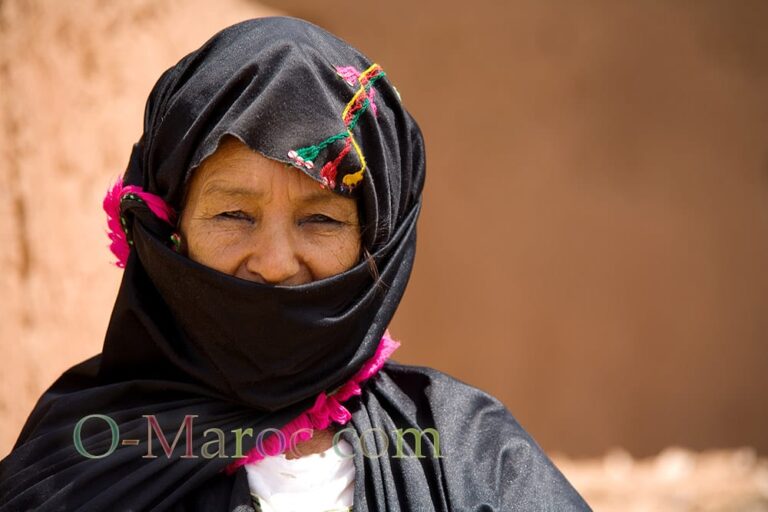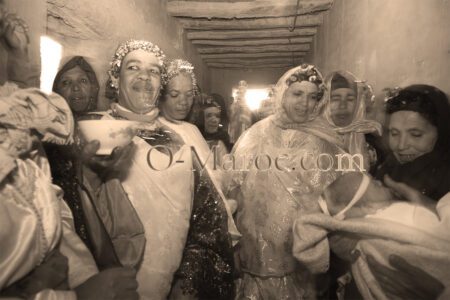Berber culture is largely oral
The Berbers call themselves “Amazigh”, men, free men, and it is the same word, in the feminine, Tamazight, which designates the language. Berber culture is defined first and foremost by its language, even if today you can still be Berber if you speak only Arabic. (And Amazigh movements have united around the defence of the language. Whether or not it is taught, whether or not it is transcribed in one character system or another, all have political implications).
This language has an alphabet, Tifinagh, which had fallen into oblivion and until the 1960s was only used in its archaic version by the Tuaregs. After independence, the system of transcription in Latin characters was abandoned, and the IRCAM developed a modern Tifinagh, which is now used in Morocco.
But for centuries, Berber culture has been a culture of orality, of stories exchanged at the oasis, of campfire tales, of proverbs and of songs sung on foot during long desert crossings.
And this love of the spoken word can be found in the songs, often embroidered and modified around an existing framework, depending on the audience, depending on what’s happening in the village… just like the women’s songs, those that punctuate the work of the singers, the countless turns of the millstone to prepare the flour for couscous and the vocal jousting that takes place at weddings.
A culture that goes back “before history”

The components of Berber culture are many and varied, but their amalgamation reveals their different origins. The Berbers were in the Maghreb before the Romans, and they take after them their Julian calendar, and no doubt their carnival rites, which now take place on Ashura.
Before being converted to Islam, they were pagans, worshippers of springs and trees, and may have inherited their respect for the moon from the Phoenicians – who had opened trading posts as far as Mauritania. Some tribes had converted to Judaism, and it is said that Kahina, the Berber queen of the Aurès who held out for so long against the Arab armies, was a Jewish queen, citing the proximity of her name to Kahen or Cohen.
It is difficult to date the arrival of the Berbers, yet their culture has remained very strong over the centuries, and for those who have lived in Morocco for a little while, it is easy to tell whether a woman is Berber or Arab by her clothes, and to recognise, even without speaking the language, the difference between Berber and Arabic, whose sounds are different, even if the languages are similar.
There are, of course, many differences between the Tuaregs, the Rifans, the Kabyle, the Chleuhs and the Amazighs (or Imazighen), but they all have one thing in common: a relatively democratic social organisation, where the chiefs were elected and where, as with the Celts, each family, each tribe, each faction was too independent to be able to ally itself with the others, There was also a common ground in the artistic motifs, the geometric decorations whose abstraction goes back to before Islam, and whose forms are again reminiscent of Celtic motifs.
For over two thousand years, Amazigh culture has resisted assimilation, or rather, has negotiated with its neighbours to ensure its continued existence. This is undoubtedly why, very often, in the depths of a small village, or under a nomad’s tent, you have the impression that time is no longer the same, and that you have embarked on a strange journey back to an ancient time.
Nomadic and farming traditions

The music is either work songs or harvest festival songs, such as the “tizrrarin”, the women’s work song, the ahwash or the ahidus. Life is marked by the rhythm of the seasons: in the past, people got married in October, after the harvest, and moussems, whether dates in Erfoud, monurl slug=”llnfl_moussem-imilchil” anchort=”tribe meeting in Imilchil”], or roses in Kelaa M'Gouna took place once the harvest was over and the money was available, so that shopping and festivities could begin.
Hospitality remains that of the nomads, for whom the guest is always entitled to a place under the tent, protection from the hostile desert, and the Berber “tea ceremony” is one of welcome and the pleasure of sharing.
Traditional medicine and the charms that protect young children are those of people who travelled the country.
The alliances, friendships and hatreds between tribes are linked to the sharing of water and grazing land, to cooperation and battles over the rare green valleys in a semi-desert country. And all this is reflected in the the rugs that young girls wove for their weddings.
And in the cities, even if the language is lost, the link remains strong with the family back in the ‘bled’ (the countryside), with the traditions handed down by parents and grandparents, and the ‘Berber touch’ can be found in many aspects of everyday life.
Traditions are very much alive, even in a modern world

Of course, depending on whether you live in a big city or a small village, traditions are lived differently on a daily basis, but they are always followed.
Whether it’s for traditional celebrations, weddings or births, Berber culture is present in everyday life. In the south, in particular, it is common to see women still dressed in traditional clothes, or wearing festive make-up with henna or saffron.
Traditional songs resound in the streets of the ksours, rugs are still made using century-old motifs, jewellery is becoming lighter and more adapted to modern life while retaining their original designs.
 A typo or syntax error? You can select the text and hit Ctrl+Enter to send us a message. Thank you! If this post interested you, maybe you can also leave a comment. We'd love to exchange with you !
A typo or syntax error? You can select the text and hit Ctrl+Enter to send us a message. Thank you! If this post interested you, maybe you can also leave a comment. We'd love to exchange with you !




